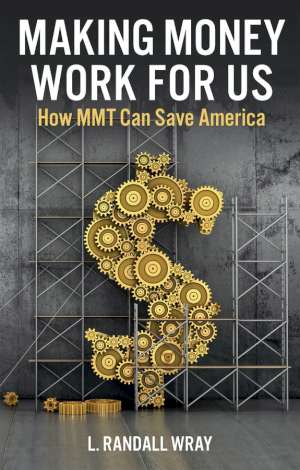24 November 2022
Making Money Work for Us
How MMT Can Save America
Randall Wray
2022, Polity Press, 224 pages,
ISBN 9781509554263
Reviewer: Melissa Davies, Redburn

This latest addition to L Randall Wray’s canon of writing on Modern Monetary Theory outlines classic MMT arguments around money - how both public and private money are created, the role of taxes in redeeming currency, the substitutability of bonds and money as alternate public liabilities, and the mirroring of public and private savings - as well as extending the application of these ideas to practical policy principles.
The first half of the book is, in essence, an operational manual on how money works. The second half builds on these operational observations to include normative principles on which progressive macroeconomic policy can be built.
This book makes particularly interesting reading in the context of the UK’s current bout of financial instability and the resounding rejection of Trussonomics by the markets. What lessons for macro policy can we draw from the recent turbulence and can MMT provide any answers?
A clear conclusion from Wray’s writings is that a low tax, libertarian macroeconomic approach is inconsistent with the policy objectives of MMT (albeit the operational observations are just as relevant to a conservative economic programme as to a progressive one).
MMT had its moment in the sun with the Covid packages and President Biden’s Build Back Better proposals. For many, the ensuing surge in inflation is just another reason to discard this supposedly unorthodox theory. But the operational observations of MMT did prove correct during the pandemic - government financing is not the fundamental constraint on government spending, resources are. Nowhere does MMT claim that government deficits are never inflationary – indeed, Wray is clear that government spending with full employment and scarce resources will create inflation.
Crucially, taxation is required to back the value of the currency, ie to allow currency to be redeemed, and to allow government to spend when inflation is high. A jobs guarantee would, in theory, give real backing to the value of the currency, although the urgency of introducing such a policy is of course diminished in the face of very tight labour markets after Covid.
While the MMT argument that government creates its own financing without the need to raise taxes or issue bonds can be proved by empirical observation, the argument that bond markets do not hold sway over government borrowing costs is arguably the most problematic of MMT’s principles. The UK’s recent travails have proved that the ‘bond vigilantes’ are alive and well. There is clearly a role for market discipline in economies that issue their own currency, as painfully experienced in the UK in recent weeks. Unless we move to an extreme MMT world where governments cease to issue bonds at all, market forces will still play a role in bond pricing and the perception of fiscal space, especially when inflation is high.
Despite this rather serious flaw, MMT is not without an answer to what has befallen the UK, with the key points alluded to in Wray’s book. Firstly, given high spending requirements on government (including the climate emergency and widening inequality), taxes must also be high – not to raise funds per se, but to support demand for the currency at a time of full employment and high inflation. Wray would argue that taxes need to be raised on the wealthy, not lowered, to combat inflation. Indeed, the state needs intelligently to create space for public spending in an inflationary environment by taking resources from the private sector via taxation.
Secondly, the financialisation of the economy, as explored in the works of Hyman Minsky and from which MMT draws some inspiration, breeds instability. This instability logically may encompass bond markets and undermine the central bank’s seemingly limitless ability to manipulate yields in MMT land. The argument that financial engineering can breed instability and allow the bond vigilantes to get a foot hold could usefully be added to MMT without undermining its core observations about how government is financed. UK pension funds’ LDI strategies amplifying the mini-budget’s shock to the UK gilt market is a case in point.
Lastly, the argument that private savings mirror public borrowing is an important one. But it fails to distinguish between domestic and foreign private savings, especially for non-dollar economies. When government borrowing is mirrored by rising private savings as during Covid, the currency and bond market outcomes have been very different to when government borrowing just drops through to the current account deficit and when private savings are under pressure – again, contributing factors to recent UK financial instability.
MMT is likely to remain a controversial theory, despite being deeply rooted in the thinking of many economists including Adam Smith, John Maynard Keynes, and Hyman Minsky. But its relevance in a world where increasing demands will be made of the public purse to deal with climate change and population ageing, to name just two challenges, will only increase. Neoliberal economics does not have the answers to dealing with multi-generational collective action problems but MMT holds many nuggets of wisdom, if it can be paired with a realistic and pragmatic understanding of financial stability, the drivers of inflation, and the limits of independent central bank’s capacity to control the bond market when the former two collide. Perhaps the most important contribution of Wray’s latest writings is to stress that MMT is not a carte blanche call for government to spend without restriction but it can nonetheless shed light on how to formulate a progressive economic agenda to face the problems of today.
